Cycling is a low-impact sport, which means, of course, that it’s easier on your joints. I’ve spoken to more than a few cyclists who only took up cycling because running was becoming just too painful on their knees. But what about cycling?
Is cycling good or bad for knees? Here’s what you need to know.
Because cycling is a low-impact sport, it is good for the knees. It helps keep the joints loose and moving and increases strength. However, pushing too hard or having an incorrect bike setup can be bad for the knees.
In this article, we’ll talk about cycling and your knees. First, we’ll go over why cycling isn’t generally bad for your knees but why knee pain might happen when you ride. Then, we’ll discuss how to fix your knee pain and the treatment options. Let’s get started.
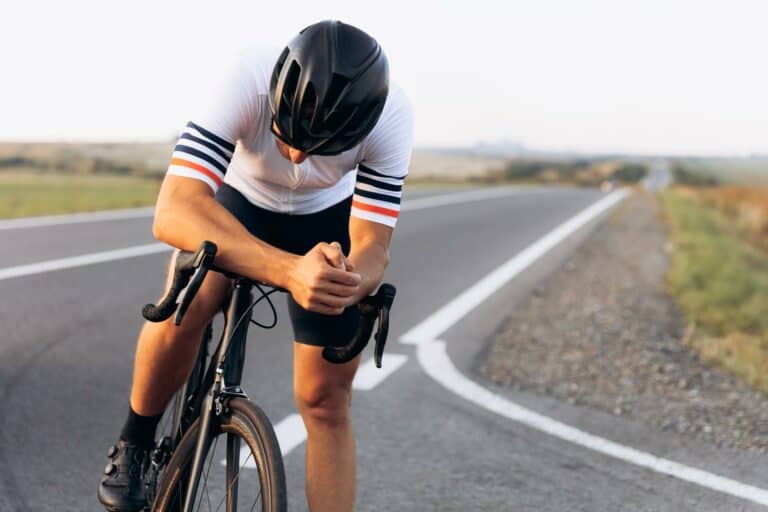
Cycling Knee Pain
Cycling is a low-impact sport because it doesn’t put too much stress on the joints, according to creakyjoints.org: “Cycling is a low-impact exercise,” says Shroyer. This means that cycling limits impact stress on weight-bearing joints, like your hips, knees, and feet.
Plus, the movement helps lubricate the joints, which reduces pain and stiffness.” Overall, cycling can help strengthen the knees and leg muscles which support the joints, which can help protect you from other types of injuries.
So is cycling good for the knees? Yes, it is! But there is a caveat.
Cycling is extremely repetitive, and the repetitive rotation of the pedals can put extra strain on the knees. Over time, this repetitive pedaling can even cause knee pain or fatigue.
In fact, knee injuries are probably the most common problem cyclists experience since the knee joint isn’t supported by contact with the bike. In addition, knee pain is more likely to happen if your bike setup isn’t right for you.
Knee problems are often preventable and fixable with the right bike fit or strength training.
Knee Pain After Cycling (Why Does This Happen?)
There are a number of reasons that you might experience knee pain after cycling. Many of these have simple fixes that take a little experimentation or help from a good bike fitter. Here are a few examples.
Saddle Position
Your saddle position may be the cause of your knee pain. If your saddle is too low or too far forward, it could contribute to pain on the front or sides of your knee. If your saddle is too high or too far back, it could contribute to pain in the back of the knee.
If you have the wrong saddle altogether, you might not be sitting correctly on the saddle, which could also cause your knees to hurt.
I had a recent issue with knee pain after lowering my saddle to try and fix a problem with a saddle sore. But trying out this new position, I started getting front knee pain. So, I raised the saddle up slightly – as one of the potential solutions – and the knee issue disappeared.
So now I’m looking at options to prevent saddle sores and knee pain. I would assume this issue is down to the ‘asynchronous’ nature of the human body – no one is a mirror image on their left and right sides, and we are all a little bit ‘wonky.’
The key is to figure out the appropriate fix to minimize the impact of this imbalance, for example, leg length discrepancy, especially when it is causing problems and pain.
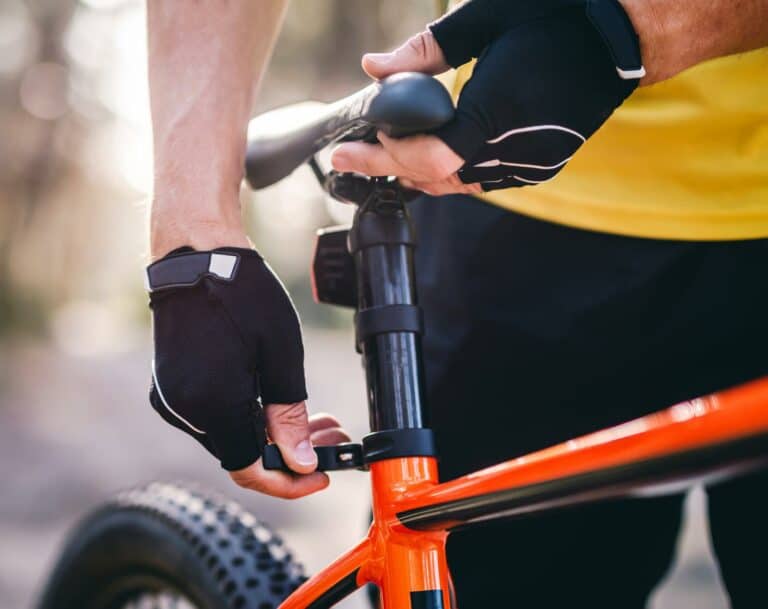
Cleat Position
Your bike shoes should be set up to mirror the way you walk. So if you walk with your toes pointed out, your cleats should be set up so your toes can point out. That being said, if your cleats are too far forward, they could be causing pain in the front of your knee.
Likewise, if your cleats aren’t positioned correctly, they could cause pain on the sides or back of your knee. The wrong cleat position can also reduce the amount of power you can put into the pedals.
Crank length
Sometimes, the length of your cranks can cause knee pain. If your cranks are too long, it might cause pain in the front of the knee because you’ll have to stretch to pedal a complete rotation. You’ll want to swap them out for shorter cranks.
Many bikes will come with a stock 170 mm crank, which is often too long for shorter riders.
General Bike Fit and Body Position
If your bike doesn’t fit you right, you might be overcompensating with your bike position, which puts strain on your knees. You might also compromise your body position to compensate for an injury or anxiety on the bike.
For example, if I don’t have the right type of saddle when I ride, I find myself turning my pelvis in the wrong direction to avoid saddle discomfort. Unfortunately, that means I’m no longer sitting correctly on the saddle, I can’t reach the pedals correctly, and I can’t reach the handlebars well.
Soon, my lower back, legs, and knees hurt because I’m trying to get comfortable on my bike. But once I swap out the wrong saddle for the right one, everything lines back up, and my ride is comfortable again.
The same issues can happen if your handlebars are too low or too far away. Or perhaps your saddle is too far back. If your position on the bike isn’t right, you might feel it in your knees the most.
So if you haven’t had a professional bike fit but have knee or other types of pain, you definitely want to consider it. A good bike fitter can make you much more comfortable on the bike, help you prevent pain and injury, and in some cases, increase your power, too.
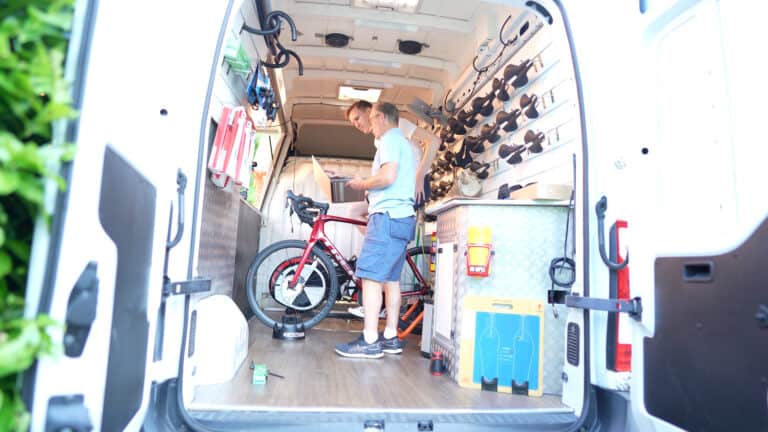
Making Bike Changes
If you’ve changed something on your bike, you might want to consider if that is the cause of your knee pain. New equipment might not fit you correctly, or old equipment might become worn.
For example, if your cleats are worn out, your foot position on the pedal may have shifted just enough to put pressure on your knees, giving you pain and discomfort. On the other hand, if you recently swapped out your crankset, you’ll need to ensure the cranks are the right length.
Sometimes, your body needs time to adjust to the changes on your bike. When you are making changes, try to make them a little bit at a time so your body can adjust without pain.
And don’t go and knock out a century ride on the first outing of a kit change. Ease in with a few short rides, or get a few rides in on the turbo first if that’s an option.
Spring Knee Pain: Too much too soon
If you suddenly increase your training load or quantity, you can cause knee pain. This is affectionately known as spring knee pain because it can crop up in the early season when you’re just ramping up your training activities.
The extra stress and strain on the knees without working up to it can cause your knees to hurt. As a result, you may need to back off your training, rest up, and make the increases more slowly.
Mashing the pedals too hard
I’ll admit it. I like grinding the pedals a bit too much, especially on climbs. But if you spend most of your time at a low cadence – like 60RMPS, you might be working your muscles too hard, making your knees hurt.
If you find your knees are fatigued and sore, try shifting to an easier gear and spinning a higher cadence – around 85 to 90 – to take the pressure off. In fact, one of my friends with a non-bike-related knee injury would spin at a cadence over 100, so he could ride without pain.
If you find that your knees are starting to hurt over the course of the ride, ease up on the power and spin more quickly. This will make your heart and lungs work harder and allow your muscles to work freely and with less stress.
You have an off-the-bike injury
Did you trip, fall, or have an off-the-bike accident? This could cause pain that you feel when riding. If you have knee pain during or after riding and it isn’t getting resolved with the right bike fit, you’ll probably want to visit your local healthcare practitioner to find out what’s going on.
You may need therapy or some other treatment to solve the pain problem.
Start Problem-Solving to Stop Your Knee Pain
If you’re experiencing knee pain on the bike, you’ll want to look at the various options to problem-solve and get treatment. The book Bike Fit by Phil Burt offers a simple problem-solving approach to figuring out what’s causing your knee pain.
- Activity: Has your training load, intensity, or terrain changed?
- Equipment: Has your equipment or setup changed? Is something worn out or needs to be adjusted?
- Intrinsic: Is something happening inside you, such as an injury, leg length discrepancy, or another issue?
- Other: Have you been sick or had an off-the-bike injury?
- Unknown: If you can’t figure out the issue, it might be time for a doctor’s visit or strengthening exercises and physical therapy.
How to Prevent Cycling-Related Knee Injuries
Get a Good Bike Fit
You’ve probably heard this a hundred times: get a good bike fit! Cycling shouldn’t be painful – it really should be an enjoyable experience on the bike (well, except for those super hard efforts, but that’s another issue altogether).
So if you are experiencing pain on the bike, especially knee pain, you need to look at how your bike fits you. You need to check your frame size, saddle position, cleat position, reach, and saddle type just to get started.
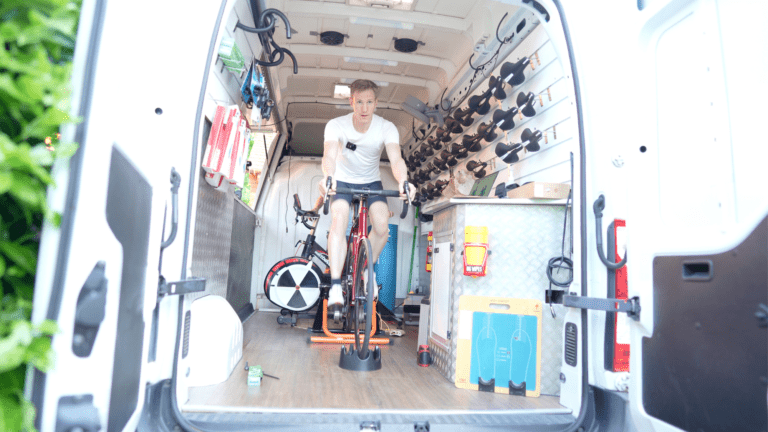
Strength Training
Sometimes, knee pain happens because the muscles in your legs just aren’t strong enough or because you have a muscle imbalance in the body that puts pressure on your knees.
Find a strength training routine that works for you and your body. Strengthen your core, glutes, quads, and hamstrings to help your position on the bike.
According to bicycling.com, you can do a few exercises to specifically strengthen the knees and reduce knee pain on the bike. For example, single-leg deadlifts, glute bridges, and donkey kicks can help.
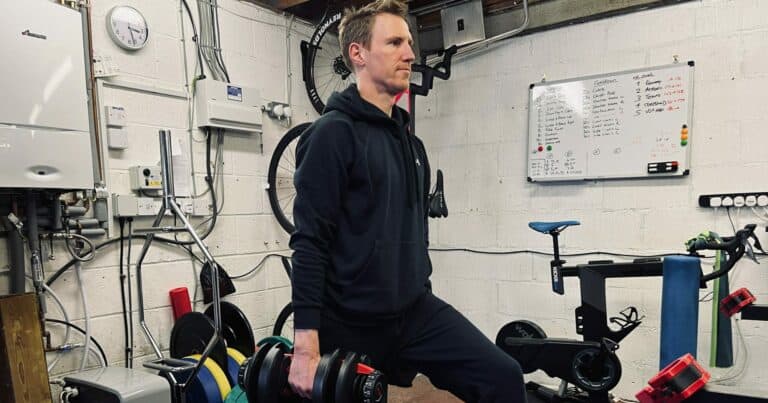
Do Some Warmups Before You Ride
Jumping into a hard ride is a real recipe for disaster. So you’re better off doing some activating stretches and warmups first. Check out this video from GCN on how to warm up well. It will help you prevent injuries and perform better.
Do Some Stretching After Your Ride
Just like pre-ride warmups, aim to fit in some post-ride stretching and warmdowns into your routine when you finish a ride. Jump off your bike, get warm (if it’s cold), get some food, and then relax into longer stretch holds. Or perhaps a yoga routine may work for you.
Ease Up On the Pedals
We already talked about how grinding in hard gears can cause knee pain. The fix is simple – ease up on the pedals.
You can generate the same number of watts (that’s just a number that cyclists use to represent the amount of power they can put into the pedals) by pushing a hard gear at a low cadence as you can by spinning an easy gear with a high cadence. The latter is much easier on your knees.
See Your Doctor
Don’t keep suffering in silence! If your pain is still hampering your ability to ride or function, you need to see a doctor and get it taken care of. Ask your doctor about your options so you can return to your bike.
Knee Pain After Cycling Remedy (Closing Thoughts)
Knee pain doesn’t have to end your cycling. Most of the time, it’s entirely fixable. The remedies include proper bike fit, proper technique, strength training, warming up, and visiting your doctor if you still have knee pain after cycling.
Cycling Knee Pain FAQ
How Common is Cycling Knee Pain?
Cycling knee pain is likely to be the most common issue among cyclists. The knee is a complex joint responsible for supporting the body’s weight and providing movement for the leg. As such, it is particularly susceptible to overuse and strain injuries.
Common causes of cycling knee pain include improper bike fit, muscular imbalances, overuse, and trauma. The most common type of cycling knee pain is patellofemoral pain syndrome, which is characterized by pain around the kneecap.
Other types of knee pain include iliotibial band syndrome, which affects the outside of the knee, and medial collateral ligament injuries, which affect the inside of the knee.
Can cycling damage your knees?
Cycling can damage your knees if you consistently ride with unmitigated knee pain. In addition, stress on your knees from an improper fit, poor technique, an injury, or low muscle tone can damage your knees over time.
If you have knee pain, take care of it before it becomes a permanent problem.
Is cycling good or bad for knee pain?
Cycling can be good for knee pain. Studies show that cycling is good for sore, stiff joints that are related to inactivity or arthritis. However, if you have an injury, you must talk to your doctor before cycling because it can worsen the pain.
Is biking good for knee rehab?
Yes, indoor cycling is often prescribed for patients needing rehab. Because it is low impact and you can adjust the amount of tension on the pedals, indoor cycling is an easy way to get the joints moving.
I know someone who recently had knee replacement surgery, and along with stretching exercises, the physio also prescribed cycling on a stationary bike to help mobilize and strengthen the knee.
How to Recover from Knee Pain
Recovering from knee pain will depend on what caused it and the severity. Resting the knee and avoiding activities that aggravate the pain is essential. Applying ice and elevating the knee can also help reduce inflammation and discomfort.
Physical therapy can aid in strengthening the muscles around the knee and improving the range of motion.
